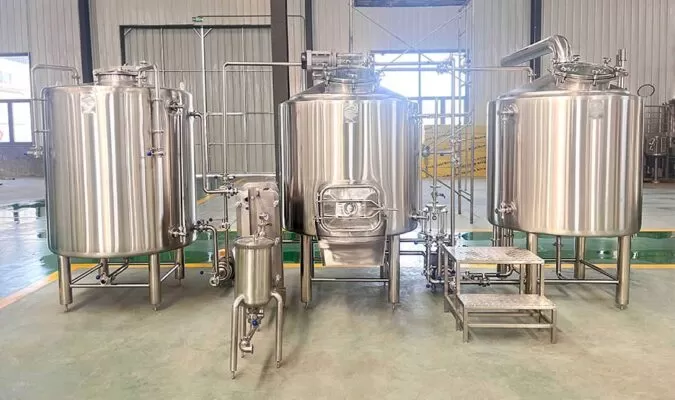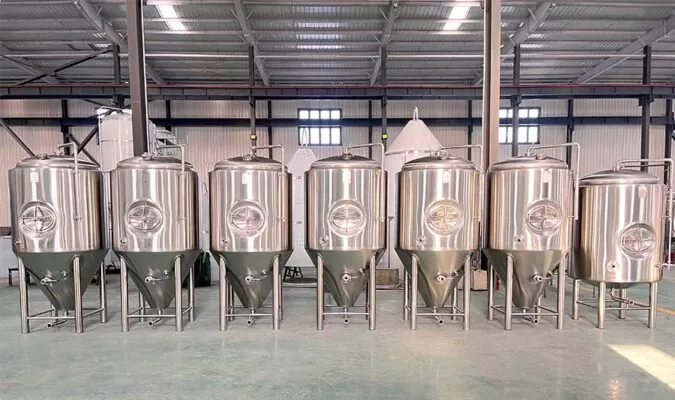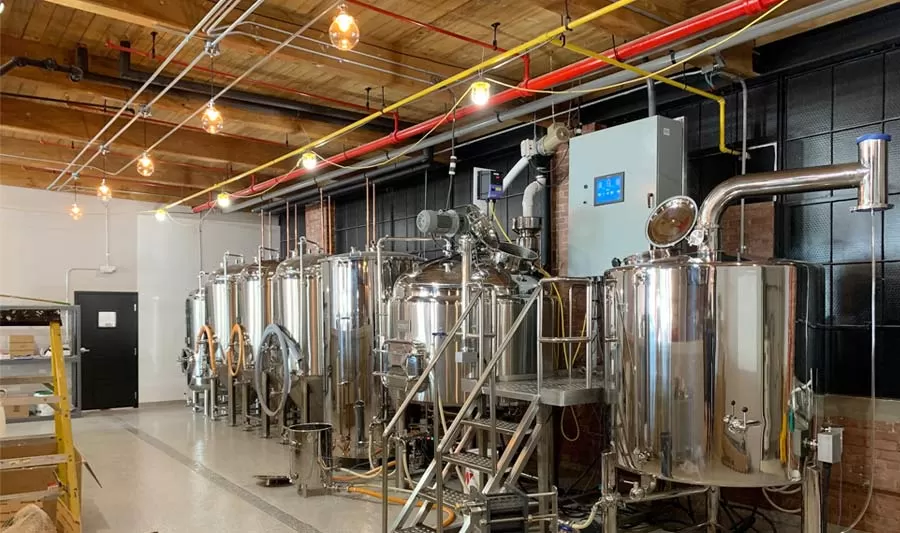Breweries come in all sizes, and the one that’s right for yours will depend on a variety of factors, including your production capabilities, budget, and brewing style. Choosing the right brewing system for a small brewery is a crucial decision.
Determine brewery size
- Large brewery: defined as a brewery that produces more than 6,000,000 barrels (7,100,000 hectolitres) of beer per year. Large breweries operate large breweries and hold a significant position in the beer industry production volume and market share.
- Small breweries: Producing less than 15,000 barrels (17,600 hectolitres) of beer per year. Small breweries are often owned and focus on brewing unique craft beers.
- Nanobrewery: A brewery that produces less than 500 barrels (590 hectolitres) of beer per year. This is less than the output of small breweries, generally defined as breweries that produce less than 15,000 barrels (17,600 liters) of beer per year.
Determine the size of your microbrewery, which will reflect the size and capacity of your brewing system. If a brewery is too small, the space will become crowded. If your brewery is too big, you’ll be wasting valuable start-up costs on square footage that won’t be used.
- Nano Brewery Equipment (1BBL-5BBL)
- Brewpub Brewing Equipment(5BBL-10BBL)
- Microbrewery Equipment (10BBL-20BBL)
- Commercial Brewery Equipment(20BBL-50BBL)

Factors to consider when choosing a small brewery size
- What is your annual production target? Brewery size = annual production / (number of brews per week x number of brewing weeks per year)
- What is your business model? Is it a brewpub with on-site consumption, a brewery with a taproom but no distribution, or a production brewery with a taproom and distribution?
- What space do you contribute to the brewery? the largest output per square foot of production area is approximately 1BBL/year.
- How many times per day and per week do you plan to brew?
- How many fermentation tanks do you plan to buy? Do you plan to add more tanks in the future?
- How much bottled beer will you drink? What is the dominant style?
- What is the ceiling height of the brewery? While some equipment can be customized to fit the space, this may impact your brewery’s capacity.
- What heat source does your brewery need? Do you have space for additional equipment (boiler, etc.)? Can you add flues/vents to the space? What is electrical service?
Small brewery brewing system configuration
Brewing vessels serve the purpose of water treatment through the processes of mixing, fermentation and storage, making beer delicious and nutritious. The equipment includes mash barrels, filter barrels, whirlpool kettles and fermenters. So it’s important to determine the system configuration that suits your needs.
2 vessel brewing system
2 brewery vessels are a popular choice for small breweries such as brewpubs or home breweries. This setup is designed for efficient brewing without taking up too much space.
Here are the three most common brewing vessel combinations used in 2-vessel breweries:
- Mash/filtering barrel/hot liquid tank combination container + brewing kettle/whirlpool
- Masking/Lauter Barrel + Brewing Pot/Whirlpool
- Mash/kettle + filter/whirlpool
3 vessel brewing system
The 3 brewery vessel is ideal for breweries requiring more complex brewing processes. The setup includes separate vessels for the mash, filter, and brew kettle, allowing for greater flexibility in the brewing process.
Three common brewing vessel combinations:
- Mash tun/kettle + filter + whirlpool tank
- Mashing/Lauter Tank + Brewing Kettle + Whirlpool
- Mash mixer + lauter barrel + brewing kettle/whirlpool
You can choose a brewing system that’s right for you based on your needs, and your choice of combination container will depend on your brewery’s specific needs.
Brewery space layout
When choosing a microbrewing system, consider the space available in your brewery. Make sure the system you choose will fit into your facility while still allowing for proper ventilation, workflow, and accessibility for maintenance and cleaning. It’s also important to plan for future expansion, as your brewery may grow over time.

Brewing styles and types of beer
Consider the type of beer you plan to produce. Certain brewing systems are better suited to specific styles. Some brewing systems are designed for traditional beers, while others are optimized for pale ales, sours, or experimental beers. Many breweries have noticed an increase in demand for higher-alcohol beers, often called India Pale Ales.
Automation equipment and control
The control system is the brains of the microbrewing system, managing the brewing process and ensuring consistency and quality. There are manual, semi-automatic and automatic control systems available. Determine the level of automation that suits your brewing style and budget, keeping in mind that more advanced control systems may must a larger initial investment but can save time and labor costs in the long run. Advanced control systems can improve efficiency and repeatability, but may also increase costs. Consider features such as touch-screen interfaces, data logging and remote monitoring.
Device integration and compatibility
Consider how your chosen brewing equipment will integrate with existing or planned systems. Ensure compatibility with auxiliary systems such as glycol chillers, barrel or canning lines, filtration systems and control systems. A cohesive and compatible setup will streamline your brewing process, increase efficiency and run.
Brewing Equipment Prices and Budgets
Budget is always an important consideration when purchasing a brewing system. Remember, the initial cost of the system is only a part of the expense. You should also consider installation costs, ongoing maintenance, and any necessary upgrades or expansions. While it may be tempting to go with the cheapest option, remember that investing in quality equipment can save you money and hassle in the long run.
Supplier reputation
Choose a reputable supplier with a proven track record of providing quality brewing equipment and excellent customer support. Conduct thorough research by reading vendor reviews, seeking advice from industry professionals, and evaluating the vendor’s expertise and responsiveness. Reliable support and service will be invaluable throughout the equipment selection, installation and maintenance process.
Small brewery equipment initial costs
How much does it cost to open a craft brewery? Costs vary based on the size of your business. Equipment prices vary. Most craft brewery equipment costs around $15,000 or more. These start-ups feature two-barrel production or small-batch distillations.
Things to consider early in your brewery evaluation:
- Production breweries must one brewhouse to manage 15 barrels. Smaller breweries must a lot of labor to break even. Applying too much pressure to the device may cause damage to it.
- The production brewery invests approximately $200,000 in equipment before opening.
- Most breweries perfect at least 5-10 different beer recipes before they start selling their products to the public.
- License and other requirements must be completed weeks before the business is ready to open.
Most Popular Small Brewing Equipment
Breweries come in all shapes and sizes, and Micet can give you some suggestions based on the most popular brewery sizes. If you are starting out, a 5 barrel or 7 barrel brewery might be a good choice. These systems are small and affordable, making them ideal for brewers who are getting started. They also offer different heating options so they can suit a variety of spaces and budgets.
If you are looking for a more powerful brewery, a 10 or 15 barrel brewery may be more suitable. These systems offer more brewing capabilities and allow you to try more recipes.




